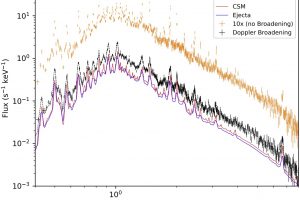Simulated the XRISM observations of the iconic supernova remnant SN1987 A. The study: “Probing Shocked Ejecta in SN 1987A: A novel diagnostic approach using XRISM−Resolve” of V. Sapienza (UNIPA/OAPA) accepted on ApJL

SN1987 A is one of the most significant objects for studying supernova explosions and their remnants. This is because it is the only core-collapse supernova that has occurred relatively close to us (approximately 170000 light-years away, in the Large Magellanic Cloud) in the modern epoch. Therefore, it is the sole object of this type for which we have telescope observations of the progenitor, the supernova, and the remnant. SN1987 A is also continuously monitored across all wavelengths to observe and study its development and evolution.
The X-ray emission from SN1987 A is particularly crucial as it provides insights into the high-energy phenomena taking place in the material heated by the shocks in the remnant. Just six months after the explosion (which occurred on February 23, 1987), the Ginga satellite observed the emission of highly energetic (10-30 keV) X-ray photons from SN1987 A. Approximately four years later, less energetic (0.1-2.4 keV) X-ray photons were detected with the ROSAT satellite.
The global X-ray emission from SN1987 A has continuously increased during its evolution, even though the low-energy component has decreased. Detailed 3D magnetohydrodynamic simulations, developed by astronomers from our Observatory, tracking the global evolution of the remnants, have demonstrated that it can be divided into three distinct phases. In the first phase, the X-ray emission is generated by the circumstellar material heated by the forward shock produced by the supernova. In the second phase, the shock reached a dense circumstellar cloud with the morphology of a ring. The third phase is commencing in this period, and it will be dominated by the emission from the stellar fragments ejected by the explosion (the ejecta) heated by the reverse shock, produced by the incidence of the forward shock on the dense circumstellar material.
SN1987A will be observed with the XRISM satellite, developed by the Japanese Space Agency (JAXA) and NASA. Thanks to its revolutionary high-resolution spectrograph, XRISM will enable astronomers to observe emissions from various chemical elements and resolve the dynamical components of supernova remnants with unprecedented precision. The efficacy of XRISM in this field has already been demonstrated through preliminary observations of another supernova remnant (N132D), recently made available (link).
The figure (click here to view the entire image) displays the synthesized XRISM spectrum of SN1987 A, developed in this study. The black spectrum incorporates all the physical and dynamical components considered in this study. The orange spectrum, shifted along the y-axis for better visualization, excludes the effects of Doppler and instrumental broadening. The red curve isolates the spectrum emitted by the shocked circumstellar material, while the blue curve represents the ejecta.
Mario Giuseppe Guarcello ( follow mariospiegacose) ( mariospiegacose) ( follow mariospiegacose)
Follow the Astronomical Observatory of Palermo on Facebok and on Instagram
Subscribe the Youtube channel of the Astronomical Observatory of Palermo
